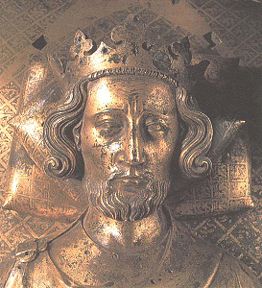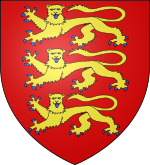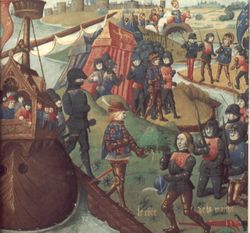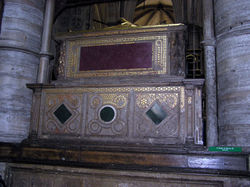Pl23 Henry III of England
| Henry III | |
|---|---|
| King of England; Lord of Ireland (more...) | |
 |
|
| Tomb effigy of Henry III | |
| Reign | 18-19 October 1216 - 16 November 1272 |
| Coronation | 28 October 1216, Gloucester
17 May 1220, Westminster Abbey |
| Predecessor | John |
| Regent | William
Marshal, 1st Earl of Pembroke (1216–1219)
Hubert de Burgh, 1st Earl of Kent (1219–1227) |
| Successor | Edward I |
| Consort | Eleanor of Provence |
| Issue | |
| Edward
I
Margaret, Queen of Scots Beatrice, Duchess of Brittany Edmund "Crouchback", 1st Earl of Leicester and Lancaster |
|
| Titles and styles | |
| The King
Henry Plantagenet |
|
| Royal house | House of Plantagenet |
| Father | John "Lackland" |
| Mother | Isabella of Angouleme |
| Born | 1 October 1207(1207-10-01)
Winchester Castle, Hampshire |
| Died | 16 November 1272 (aged 65)
Westminster, London |
| Burial | Westminster Abbey, London |
Henry III (1 October 1207 – 16 November 1272) was the son and successor of John "Lackland" as King of England, reigning for fifty-six years from 1216 to his death. His contemporaries knew him as Henry of Winchester. He was the first child king in England since the reign of Ethelred the Unready. Despite his long reign, his personal accomplishments were slim and he was a political and military failure. England, however, prospered during his century and his greatest monument is Westminster, which he made the seat of his government and where he expanded the abbey as a shrine to Edward the Confessor.
He assumed the crown under the regency
of the popular William
Marshal, but the England he inherited had undergone several drastic
changes in the reign of his father. He spent much of his reign fighting
the barons over Magna
Carta[citation
needed] and the royal rights, and was eventually forced
to call the first "parliament"
in 1264. He was also unsuccessful on the Continent, where he endeavoured
to re-establish English control over Normandy,
Anjou, and
Aquitaine.
Contents |
Coronation
Henry III was born in 1207 at Winchester Castle. He was the son of King John and Isabella of Angoulême. After his father's death in 1216, Henry, who was nine at the time, was hastily crowned in Gloucester Cathedral; he was the first child monarch since the Norman invasion of England in 1066. The coronation was a simple affair, attended by only a handful of noblemen and three bishops. None of his father's executors was present, and in the absence of a crown a simple golden band was placed on the young boy's head, not by the Archbishop of Canterbury (who was at this time supporting Prince Louis of France, the newly-proclaimed king of England) but rather by the Bishop of Gloucester. In 1220, a second coronation was ordered by Pope Honorius III who did not consider that the first had been carried out in accordance with church rites. This occurred on 17 May 1220 in Westminster Abbey.[1]
Under John's rule, the barons
had supported an invasion
by Prince Louis because they disliked the way that John had ruled the country.
However, they quickly saw that the young prince was a safer option. Henry's
regents
immediately declared their intention to rule by Magna
Carta, which they proceeded to do during Henry’s minority. Magna
Carta was reissued in 1217 as a sign of goodwill to the barons and the
country was ruled by regents until 1227.
Attitudes and beliefs during his reign
Henry was much taken with the cult of the Anglo-Saxon
saint king Edward
the Confessor who had been canonised in 1161. Told that St Edward dressed
austerely, Henry took to doing the same and wearing only the simplest of
robes. He
had a mural
of the saint painted in his bedchamber
for inspiration before and after sleep and even named his eldest son Edward.
Henry designated Westminster,
where St Edward had founded the abbey, as the fixed seat of power in England
and Westminster
Hall duly became the greatest ceremonial space of the kingdom, where
the council of nobles also met. Henry appointed French architects from
Rheims
to renovate Westminster
Abbey in the Gothic
style. Work began, at great expense, in 1245. The centrepiece of Henry's
renovated abbey was to be a shrine to Edward the Confessor. It was finished
in 1269 and the saint's relics were then installed.
| English Royalty |
|---|
| House of Plantagenet |

Armorial of Plantagenet |
| Henry III |
| Edward I Longshanks |
| Margaret, Queen of Scots |
| Beatrice, Duchess of Brittany |
| Edmund, Earl of Lancaster |
Henry was known for his anti-Jewish decrees, such as a decree compelling them to wear a special "badge of shame" in the form of the Two Tablets. Henry was extremely pious and his journeys were often delayed by his insistence on hearing Mass several times a day. He took so long to arrive on a visit to the French court that his brother-in-law, King Louis IX of France, banned priests from Henry's route. On one occasion, as related by Roger of Wendover, when King Henry met with papal prelates, he said, "If (the prelates) knew how much I, in my reverence of God, am afraid of them and how unwilling I am to offend them, they would trample on me as on an old and worn-out shoe."
Criticisms
Henry's advancement of foreign favourites,
notably his wife's Savoyard uncles and his own Lusignan
half-siblings, was unpopular with his subjects and barons. He was also
extravagant and avaricious; when his first child, Prince
Edward, was born, Henry demanded that Londoners bring him rich gifts
to celebrate. He even sent back gifts that did not please him. Matthew
Paris reports that some said, "God gave us this child, but the king
sells him to us."
Wars and rebellions
In 1244, when the Scots threatened to invade England, King Henry III visited York Castle and ordered it rebuilt in stone. The work commenced in 1245, and took some 20 to 25 years to complete. The builders crowned the existing moat with a stone keep, known as the King's Tower.Henry's reign came to be marked by civil strife as the English barons, led by Simon de Montfort, demanded more say in the running of the kingdom. French-born de Montfort had originally been one of the foreign upstarts so loathed by many as Henry's foreign councillors; after Henry, on an anger outbrust, accused Simon of seducing his sister and forcing him to give her to Simon to avoid an scandal, when confronted by the Barons about the secret marriage between the two that Henry had allowed to happen, a feud developed between the two. Their relationship reached a crisis in the 1250s when de Montfort was brought up on spurious charges for actions he took as lieutenant of Gascony, the last remaining Plantagenet land across the English Channel. He was acquitted by the Peers of the realm, much to the King's displeasure.
Henry also became embroiled in funding a war in Sicily on behalf of the Pope in return for a title for his second son Edmund, a state of affairs that made many barons fearful that Henry was following in the footsteps of his father, King John, and needed to be kept in check, too. De Montfort became leader of those who wanted to reassert the Magna Carta and force the king to surrender more power to the baronial council. In 1258, seven leading barons forced Henry to agree to the Provisions of Oxford, which effectively abolished the absolutist Anglo-Norman monarchy, giving power to a council of fifteen barons to deal with the business of government and providing for a thrice-yearly meeting of parliament to monitor their performance. Henry was forced to take part in the swearing of a collective oath to the Provisions of Oxford.
In the following years, those supporting de Montfort and those supporting the king grew more and more polarised. Henry obtained a papal bull in 1262 exempting him from his oath and both sides began to raise armies. The Royalists were led by Prince Edward, Henry's eldest son. Civil war, known as the Second Barons' War, followed.
The charismatic de Montfort and his forces had captured most of southeastern England by 1263, and at the Battle of Lewes on 14 May 1264, Henry was defeated and taken prisoner by de Montfort's army. While Henry was reduced to being a figurehead king, de Montfort broadened representation to include each county of England and many important towns—that is, to groups beyond the nobility. Henry and Edward continued under house arrest. The short period that followed was the closest England was to come to complete abolition of the monarchy until the Commonwealth period of 1649–1660 and many of the barons who had initially supported de Montfort began to suspect that he had gone too far with his reforming zeal.
But only fifteen months later Prince Edward had escaped captivity (having been freed by his cousin Roger Mortimer) to lead the royalists into battle again and he turned the tables on de Montfort at the Battle of Evesham in 1265. Following this victory savage retribution was exacted on the rebels.Death
Henry's reign ended when he died in 1272, after which he was succeeded by his son, Edward I. His body was laid, temporarily, in the tomb of Edward the Confessor while his own sarcophagus was constructed in Westminster Abbey.Appearance
According to Nicholas Trivet, Henry was a thickset man of medium height with a narrow forehead and a drooping left eyelid (inherited by his son, Edward I). Marriage and children
Married on 14 January 1236, Canterbury
Cathedral, Canterbury,
Kent, to Eleanor
of Provence, with at least five children born:
- (Pl22) Edward I (b. 17 January 1239 - d. 8 July 1307)
- Margaret (b. 29 September 1240 - d. 26 February 1275), married King Alexander III of Scotland
- Beatrice (b. 25 June 1242 - d. 24 March 1275), married to John II, Duke of Brittany
- Edmund (16 January 1245 - d. 5 June 1296) m 1st Aveline dau of Lord of Aumâle and Holderness m 2nd Blanche dau of Count of Artois and had Thomas 2nd Earl of Lanccaster and Henry 3rd Earl of Lancater and John Lord Beaufort
- Katharine (b. 25 November 1253 - d. 3 May 1257), deafness was discovered at age 2. [1]
- Richard (b. after 1247 - d. before 1256),
- John (b. after 1250 - d. before 1256), and
- Henry (b. after 1253 - d. young)
- William (b. and d. ca. 1258) is an error for the nephew of Henry's half-brother, William de Valence.
Personal details
- His Royal Motto was qui non dat quod habet non accipit ille quod optat (He who does not give what he has, does not receive what he wants).
- His favourite wine was made with the Loire Valley red wine grape Pineau d'Aunis which Henry first introduced to England in the thirteenth century. [2]
- He built a Royal Palace in the town of Cippenham, Slough, Berkshire named "Cippenham Moat".
- In 1266, Henry III of England granted the Lübeck and Hamburg Hansa a charter for operations in England, which contributed to the emergence of the Hanseatic League.
Fictional portrayals
In The Divine Comedy Dante sees Henry ("the king of simple life") sitting outside the gates of Purgatory with other contemporary European rulers.Henry is a prominent character in Sharon Penman's historical novel Falls the Shadow; his portrayal is very close to most historical descriptions of him as weak and vacillating.
Henry has been portrayed on screen as a child by Dora
Senior in the silent short King John (1899), a version of John's
death scene from Shakespeare's
King
John, and by Rusty
Livingstone in the BBC
Shakespeare The Life and Death of King John (1984). He was portrayed
as an adult by Richard
Bremmer in Just
Visiting (2001), a remake of the French time travel film Les
Visiteurs.
Ancestors
|
|
||||||||||||||||||||||||||||||||||||||||||||||||||||||||||||||||||||||||||||||||||||||||||||||||||||||||||||||||||||||||||||||||||||||||||||||||||||||||||||||||||||||||||||||||||||||||||||||||||||||||||||||||||||||||||||||||||||||||||||||||||||||||||||||||||||||||||||||||||||||||||||||||||||||||||||||||||||||||||||||||||||||||||||||||||||||||||||||||||||||||||||||||||||||||||||||||||||||||||||||||||||||||||||||||||||||||||||||||||||||||||||||||||||||||||||||||||||||||||||||||||||||||||||||||||||||||||||||||||||||||||||||||||||||||||||||||||
|---|---|---|---|---|---|---|---|---|---|---|---|---|---|---|---|---|---|---|---|---|---|---|---|---|---|---|---|---|---|---|---|---|---|---|---|---|---|---|---|---|---|---|---|---|---|---|---|---|---|---|---|---|---|---|---|---|---|---|---|---|---|---|---|---|---|---|---|---|---|---|---|---|---|---|---|---|---|---|---|---|---|---|---|---|---|---|---|---|---|---|---|---|---|---|---|---|---|---|---|---|---|---|---|---|---|---|---|---|---|---|---|---|---|---|---|---|---|---|---|---|---|---|---|---|---|---|---|---|---|---|---|---|---|---|---|---|---|---|---|---|---|---|---|---|---|---|---|---|---|---|---|---|---|---|---|---|---|---|---|---|---|---|---|---|---|---|---|---|---|---|---|---|---|---|---|---|---|---|---|---|---|---|---|---|---|---|---|---|---|---|---|---|---|---|---|---|---|---|---|---|---|---|---|---|---|---|---|---|---|---|---|---|---|---|---|---|---|---|---|---|---|---|---|---|---|---|---|---|---|---|---|---|---|---|---|---|---|---|---|---|---|---|---|---|---|---|---|---|---|---|---|---|---|---|---|---|---|---|---|---|---|---|---|---|---|---|---|---|---|---|---|---|---|---|---|---|---|---|---|---|---|---|---|---|---|---|---|---|---|---|---|---|---|---|---|---|---|---|---|---|---|---|---|---|---|---|---|---|---|---|---|---|---|---|---|---|---|---|---|---|---|---|---|---|---|---|---|---|---|---|---|---|---|---|---|---|---|---|---|---|---|---|---|---|---|---|---|---|---|---|---|---|---|---|---|---|---|---|---|---|---|---|---|---|---|---|---|---|---|---|---|---|---|---|---|---|---|---|---|---|---|---|---|---|---|---|---|---|---|---|---|---|---|---|---|---|---|---|---|---|---|---|---|---|---|---|---|---|---|---|---|---|---|---|---|---|---|---|---|---|---|---|---|---|---|---|---|---|---|---|---|---|---|---|---|---|---|---|---|---|---|---|---|---|---|---|---|---|---|---|---|---|---|---|---|---|---|---|---|---|---|---|---|---|---|---|---|---|---|---|---|---|---|---|---|---|---|---|---|---|---|---|---|---|---|---|---|---|---|---|---|---|---|---|---|---|---|---|---|---|---|---|---|---|---|---|---|---|---|---|---|---|---|---|---|---|---|---|---|---|---|---|---|---|---|---|---|---|---|---|---|---|---|---|---|---|---|---|---|---|---|---|---|---|---|---|
|
||||||||||||||||||||||||||||||||||||||||||||||||||||||||||||||||||||||||||||||||||||||||||||||||||||||||||||||||||||||||||||||||||||||||||||||||||||||||||||||||||||||||||||||||||||||||||||||||||||||||||||||||||||||||||||||||||||||||||||||||||||||||||||||||||||||||||||||||||||||||||||||||||||||||||||||||||||||||||||||||||||||||||||||||||||||||||||||||||||||||||||||||||||||||||||||||||||||||||||||||||||||||||||||||||||||||||||||||||||||||||||||||||||||||||||||||||||||||||||||||||||||||||||||||||||||||||||||||||||||||||||||||||||||||||||||||||
References
- ^ "Henry III, Archonotology.org". Retrieved on 2007-12-10.
- ^ J. Robinson Vines Grapes & Wines pg 199 Mitchell Beazley 1986 ISBN 1-85732-999-6
External links
- Henry III Chronology
- Henry III of England at Genealogics
- FMG on Henry III of England
- Earliest Known Deaf Persons
| Henry III of EnglandHouse of PlantagenetBorn: 1 October 1207Died: 16 November 1272 | ||
| Regnal titles | ||
|---|---|---|
| Preceded by
John of England |
King
of England
1216 – 1272 |
Succeeded by
Edward I |
| English royalty | ||
| Preceded by
Henry V, Count Palatine of the Rhine |
Heir
to the English Throne
as heir apparent 1 October 1207 - 19 October 1216 |
Succeeded by
Richard, 1st Earl of Cornwall |
| French nobility | ||
| Preceded by
John of England |
Duke
of Aquitaine
1216 – 1272 |
Succeeded by
Edward I |
| Peerage of Ireland | ||
| Preceded by
John of England |
Lord
of Ireland
1216 – 1272 |
Succeeded by
Edward I |
| Family information | ||
|---|---|---|
| Henry
II of England
House of Plantagenet
|
John of England | Henry III of England |
| Eleanor
of Aquitaine
House of Poitiers
|
||
| Aymer
of Angoulême
House of Taillifer
|
Isabella of Angoulême | |
| Alix
of Courtenay
House of Courtenay
|
||
| Notes and references | ||
|
||||||||||||||





